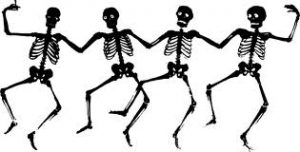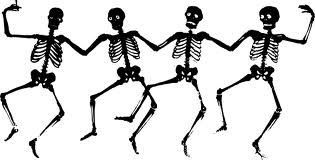 The Wisdom of “the Exorcist song”
The Wisdom of “the Exorcist song”
by – David Schmidt
Tubular Bells, minute one. In honor of Halloween, I’d like to invite you to listen to the first 30 seconds of this song, “Tubular Bells”:
http://www.youtube.com/watch?v=8LEWkwvaNcs
Now pause the song. I’m sure you recognize it—most people know it as “That Creepy Song from the Movie ‘The Exorcist’”. Go ahead, listen to another thirty seconds.
What feelings does the song evoke? Most of us associate this music with the same feelings that we associate with horror movies in general. Fear, darkness, terror. Hopelessness. We think of the pure, unadulterated horror that people feel when they watch a good, scary movie like “The Exorcist”. The sort of fear that, back when the movie originally came out 40 years ago, caused people to pass out, or vomit into the movie theater trash cans.
For most of us in the United States, Halloween is that kind of holiday. It’s a time to get temporarily terrified, for the fun of it. It’s the “roller coaster” mentality—we go into a haunted house or watch a scary movie for the purpose of being frightened by it, but we’re never really in danger.
Of course, the whole reason these things are scary in the first place is that they remind us of things we really are afraid of. A roller coaster gives us an adrenaline rush because we actually are afraid of falling from heights. Same goes for horror movies, scary books, and the entire “horror” genre—we are afraid of death. The monsters, the ghosts, the axe murderers, they all remind us of our own mortality.
I recently realized something about the “Exorcist song”, though—for most of my life, I had never heard the entire song.
Tubular Bells, minute 1:30
I’m writing this from Mexico City. I try to come here every year, during the season of the Day of the Dead, which takes place on November 1 and 2.
In recent years, the Day of the Dead has started to meld with Halloween, appropriating cultural imagery from the United States. In its original form, though, this season in Mexico is about something much more ancient than the momentary carnival thrill of Halloween.
The Day of the Dead is a festival that goes back thousands of years, to the first civilizations of ancient Mexico. It is a time to remember the dead, to commune with them. In a broader sense, it is a time to sit down and chat with death. To listen to what death has to say with us. And to listen to everything we are afraid of, and see what it has to teach us. During the Day of the Dead, we set up candlelit altars in our homes with photos of our loved ones who have passed on, and we remember them. But we also remember the fact that, where they went, there shall we go.
We sit and deliberately think about that fact.
Tubular Bells, minute two
When I was here in Mexico City last year, I bought a homemade MP3 CD from a street salesman for ten pesos. He was selling the CD’s on the metro, walking up and down the cars, announcing that they had “songs and sound effects for Halloween and the Day of the Dead”.
It’s still one of my favorite CD’s.
The disc has music from most of the classic Hollywood horror films: Friday the Thirteenth, Halloween, Nightmare on Elm Street, and—of course—The Exorcist. Most Hollywood slasher films are used as momentary, “roller coaster” type thrill rides, precisely because they are so dark. While we are watching the movie, most of the time, we see images that cause us to be afraid, to despair. In slasher flicks, typically only one person comes out alive—just barely. The hero or heroine is covered in blood, hysterical, traumatized. Jason, or Freddy, or Michael Myers, is usually still at large. The bad guy has won.
The same could be said for much horror literature.
This is the message of much of our horror genre. Scary things—the monsters in this world—are to be feared, respected, and if we tangle with them, they will usually come out on top. So we walk away from the horror movie, and we say “thank goodness that isn’t real”, and we forget about it. Except that the movie, in fact, reminded us of things that are real, that we are afraid of. But we are offered no resolution.
This is not the message of the Day of the Dead, however. The Day of the Dead—like many of the ancient Celtic festivals of pre-Christian Europe—is about recognizing death as a part of life, and about meditating on what scares us, and learning from it.
The beautiful thing about the “Tubular Bells” song is that it illustrates, quite artfully, what happens when we do that. When we choose to listen to what frightens us, to engage what scares us, rather than run away from it.
Tubular Bells, minute three
During the first couple minutes of the “Exorcist song”, the music is consistently bleak and minor key. It reminds us of that sense of dread, in the movie The Exorcist, when the priests have to walk up the stairs to the possessed girl’s bedroom, knowing something horrible waits on the other side of the door.
But something interesting happens about halfway through the song: the musical theme is redeemed.
After a few measures, some electric guitar chimes in, offering new dimensions to the music. This is what happens when we confront and engage what frightens us—what Carl Jung called “the Shadow”—rather than running from it. It begins to transform. Our fears begin to transform. What was formerly bleak and terrifying becomes more complex, multifaceted, even beautiful, like the music halfway through “Tubular Bells”.
Tubular Bells, minute four
At the end, the exact same musical theme is played—in a transformed version. What was originally something ominous and dark and minor-key has become a redeemed version of itself. The musical theme is now major key, hopeful, and uplifting. By sitting through the “dark knight of the soul”, as Saint John of the Cross might call it, by sitting with the fear rather than running from it, the darkness and fear and hopelessness have been overcome.
The concept of “listening to the dead” and learning from them exists in traditions across the globe. The Druids and other ancient peoples of Europe would remember those who had passed on as the nights got longer and the earth became barren with winter. The ancient Aztecs and other civilizations here in Mexico did the same thing. The ancient hero sagas of Beowulf and others follow this trajectory: the hero goes down into darkness, into the ocean or the cave or the earth, and comes out transformed.
This wisdom exists throughout the Judeo-Christian tradition as well. The Torah is full of tales of people who descended into “the depths”, the darkness of despair, only to come out more wise and full of hope on the other side. Jonah enters the belly of the whale and descends to the depths of the sea. Job sits through his immense sorrow, and praises God in the end.
Many of the psalms attributed to King David follow the same structure as the “Tubular Bells” song. The “lamentation psalms” begin with hopelessness and despair. The Psalmist expresses that sadness, though, rather than running from it. He inhabits it, fully feels it, expresses it, cries out. And in the end, he is full of hope and praise. Somehow, by entering into that dark night of the soul, we come out on the other end changed. We are not “barely alive and traumatized for life”, like the survivor of the slasher flick. Rather, we are made more complete as human beings.
It’s a shame that most of us have only heard the first half of “the Exorcist song”, have only heard the fear and the ominous foreboding. The full version has so much more to offer.
David J. Schmidt is a freelance writer, folklore researcher, multi-lingual translator and home brewer in San Diego, CA. He speaks eight languages, and has published writings in English and Spanish. In addition to co-authoring the Daily Book of Art and The Daily Book of Photography, he is the author of the erotica-romance parody, Pirates of the Danube, available on amazon.com and in any bookstores with the bad taste to carry the book.
You can read more of Schmidt’s work at his blog, www.donguero.blogspot.com






